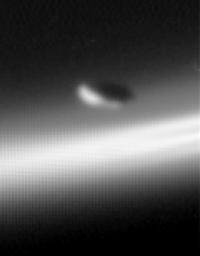In its own way, the shepherd moon Prometheus (102 kilometers, 63 miles across) is one of the lords of Saturn's rings. The little moon maintains the inner edge of Saturn's thin, knotted F ring, while its slightly smaller cohort Pandora (84 kilometers, or 52 miles across) guards the ring's outer edge.
This view is a composite of nine raw images combined in a way that improves resolution and reduces noise. The final image was magnified by a factor of five. One of the component images was previously released (see PIA06098).
The image clearly shows that Prometheus is not round, but instead has an oblong, potato-like shape. The moon was discovered during the Voyager mission, and scientists then noted ridges, valleys and craters on its surface. Hints of its varied topography are present in this view, although Cassini will likely obtain much better images of Prometheus later in the mission.
The component images were taken over about ten and a half minutes. During that time, the spacecraft's motion caused some blurring of the F ring in the background. Cassini was below the ring plane at the time the images were obtained, and the view here is across the rings toward the distant arm of the F ring. Sunlight is coming from below left.
These images were obtained with the Cassini spacecraft wide angle camera on July 1, 2004, around the time Cassini entered Saturn's orbit. The spacecraft's distance from the planet ranged from approximately 181,000 to 190,000 kilometers (112,000 to 118,000 miles) during the time the exposures were taken. The image scale is approximately 11 kilometers (7 miles) per pixel.
The Cassini-Huygens mission is a cooperative project of NASA, the European Space Agency and the Italian Space Agency. The Jet Propulsion Laboratory, a division of the California Institute of Technology in Pasadena, manages the Cassini-Huygens mission for NASA's Office of Space Science, Washington, D.C. The Cassini orbiter and its two onboard cameras, were designed, developed and assembled at JPL. The imaging team is based at the Space Science Institute, Boulder, Colo.
For more information, about the Cassini-Huygens mission visit, http://saturn.jpl.nasa.gov and the Cassini imaging team home page, http://ciclops.org.

 Planetary Data System
Planetary Data System












